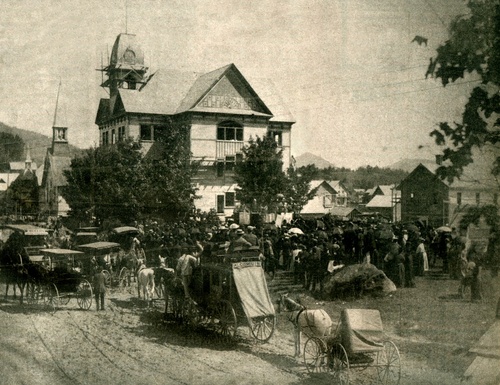 Watertown Daily Times, 1938, republished in the Adirondack Daily Enterprise, October 17, 1987
Watertown Daily Times, 1938, republished in the Adirondack Daily Enterprise, October 17, 1987  Saranac Lake High School, 1902, showing the first addition. The original Academy is visible at lower right (the building with closed shutters). 9 Academy Street is in center foreground. The photograph was taken from Blood Hill by William Henry Jackson; see Saranac Lake Village, c. 1902 (Detroit Publishing Co.)
Saranac Lake High School, 1902, showing the first addition. The original Academy is visible at lower right (the building with closed shutters). 9 Academy Street is in center foreground. The photograph was taken from Blood Hill by William Henry Jackson; see Saranac Lake Village, c. 1902 (Detroit Publishing Co.) 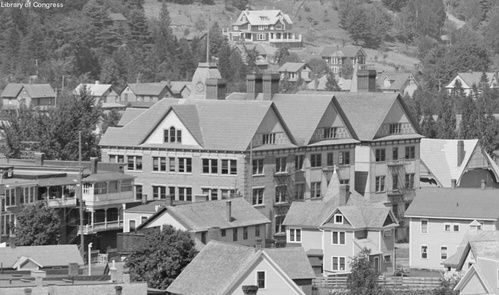 Saranac Lake High School, 1909, showing the second addition, of brick. For the full photograph, see Saranac Lake Village, c. 1909 (Detroit Publishing Co.)
Saranac Lake High School, 1909, showing the second addition, of brick. For the full photograph, see Saranac Lake Village, c. 1909 (Detroit Publishing Co.) 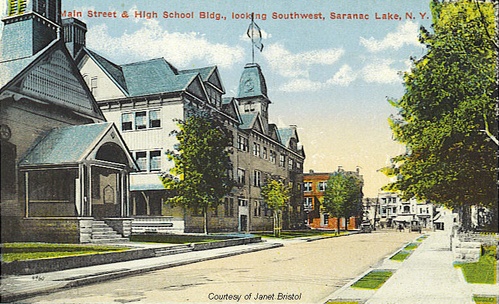 Saranac Lake High School, Main St. looking southwest, 1902. The original building of the First United Methodist Church is at the left.
Saranac Lake High School, Main St. looking southwest, 1902. The original building of the First United Methodist Church is at the left. 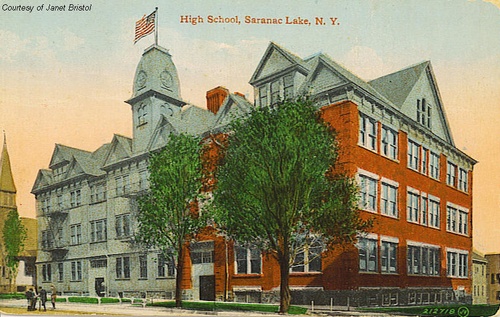 Saranac Lake High School, on Main Street, c. 1903 Three different buildings have housed the Saranac Lake High School. The first was built on Main Street in 1890, the second on Petrova Avenue in 1925, and the third, present high school in 1968, facing south toward LaPan Highway.
Saranac Lake High School, on Main Street, c. 1903 Three different buildings have housed the Saranac Lake High School. The first was built on Main Street in 1890, the second on Petrova Avenue in 1925, and the third, present high school in 1968, facing south toward LaPan Highway.
The first building to house the Saranac Lake High School was built in 1890 on Main Street; it was dedicated by U.S. President Benjamin Harrison. 1 It was built of wood on the site of an earlier academy that was moved to Academy Street to make room for the new school. It was expanded twice. Between 1895 and 1899 a wooden addition nearly as large as the original was added to the north side, and between 1899 and 1903, a second addition, slightly smaller than the first and built of brick, was added to the south. 2
In 1925, a new school was built on Petrova Avenue at a cost of $650,000, that housed kindergarten through grade twelve. 3
The dedication of the new school took place over a six day period beginning on February 16, 1925 and ending on February 21, 1925. The hand book of this dedication is in the Adirondack Room of the Saranac Lake Free Library.
In 1968 a new high school was built half a mile west of the Petrova school at a cost of nearly four million dollars; the Petrova school continued to serve grades one through eight. The new high school saw it first day of classes on December 1, 1969. The school year (1969-1970) for high school students began at the Petrova School and moved to the new building after the Thanksgiving break. The class of 1969 was the last graduating class to spend their entire senior year at Petrova. The graduating class of 1970 spent time at both Petrova and the new school, and the graduating class of 1971 as the first class to spend their entire senior year in the new high school.
Table of Contents
- Watertown Daily Times, 1938 - about the 1987 photograph
- Adirondack Daily Enterprise, March 3, 1962 - SLHS History Discovered In Old Alumni Magazine
- Adirondack Daily Enterprise, June 12, 1984 - My old Alma Mater, By Bill Mclaughlin
- Malone Gazette, December 23, 1892 - The opening of the new school building.
- Franklin Gazette, March 20, 1896 - Notice of a special school meeting on a $9,000 bond for building an addition to the school building.
- Lake Placid News, June 13, 1924 - Firemen Save Saranac Lake High School From Serious Night Fire
- First Saranac Lake High School Graduates
- Famous graduates
- Related links
Saranac Lake was not the neat, modern, spotless village it is today back in the final 1880s when the above picture was taken. In that prelude to the Gay Nineties fireproof construction was in its swaddling clothes, architecture was more or less cluttered with gingerbread adornment and only dusty, muddy dirt roads were provided for horsedrawn traffic.
It was in the summer of 1888 that Benjamin Harrison, then Republican candidate for president against Grover Cleveland, it is believed, that the photograph was taken by G. W. Baldwin.
The bewhiskered general is shown speaking from a platform near the high school in process of construction at that time. The old school house had been moved back and altered for dwelling purposes. The uncompleted new one was of ornate frame construction and furnished the nucleus for the present building. Also the present Harding block now stands near where the presidential candidate spoke. In the foreground are shown the buses of the Algonquin and Miller hotels. The crowd attending the address was of small proportions.
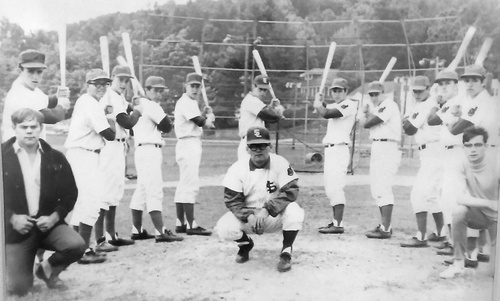 1968 Saranac Lake High School Section X Champion Baseball team at Petrova Field
1968 Saranac Lake High School Section X Champion Baseball team at Petrova Field
From left: Dave Swett, Ray Boula, Dave Favaro, Jim Clark, Brent Rushlaw, B.J. Dickie, Rod Daunais, Bob Lintner, Bob Neese, Gary Stearns, Wayne Donaldson, Terry Duso and Basil Johnson. Head coach John Raymond is in the center.Adirondack Daily Enterprise, March 3, 1962
SLHS History Discovered In Old Alumni Magazine
Last week the Redskin Review published a letter which was recently received from Mr. Lawrence J. Reid of Fort Morgan, Colorado, who attended school in Saranac Lake from 1896 - 1899, and whose two brothers graduated from Saranac Lake High School in 1898. Enclosed with the letter Mr. Reid sent a commencement program from 1889 and an alumni magazine published in 1904 parts of which we would like to print in the coming weeks. The following is a brief history of the Saranac Lake High School, written by Prof. J. E. Weld in the alumni magazine.
"The first charter granted the Saranac Lake High School was dated December 13, 1893, and incorporated it as a junior school. The number of actual academic students was very small and for several years the high school and the eighth grade were combined, doing their work in the same room.
"The first commencement exercises of this junior school were held June, 1896, and Francis Slater was the first graduate. He is accordingly the senior member of our Alumni Association. On November 18, 1898, after the purchase of the necessary equipment in library and scientific appartus the grade of the school was advanced to that of a full high school.
"The sessions of the high school were held for several years in the third floor front room of the original building. In 1898 this building was doubled in size by the erection of a wing containing six rooms. One of these new rooms on the third floor was used as a recitation room and laboratory by the growing school. Soon after, a hall room was enlarged and fitted up as a library. This served its purpose fairly well for two years when the continued growth of the school made the employment of another teacher necessary and the library was taken for a class room, the books being transferred to the large hall adjoining the laboratory. This hall, which is connected with the laboratory by an archway, was furnished with tables and chairs and has since been used as library and reading room. It contains over 2,000 volumes carefully selected with reference to their use in school and as a reading room is well stocked with the standard magazines illustrated and scientific papers, and young people's publications of the better class. The laboratory, also, is well equipped and such additions are annually made to its apparatus as are needed.
"The enlarged school was crowded to its utmost capacity in 1892 and a further increase in size became imperative. Another wing of seven rooms was added in 1903-4. The entire third floor of this wing, 36x72 feet, has been finished in one room as the assembly and study room for the high school. It has seating capacity for 150 students and with its high arched celling good light and handsome finish is a very attractive room. The high school at present consists of the large assembly room, three class rooms and the library."
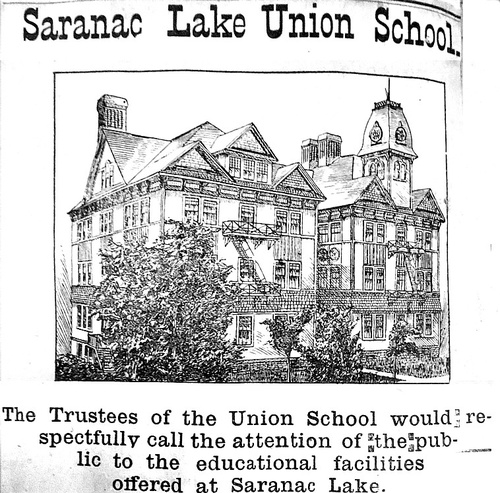
From "Scrapook No. 1" at the Saranac Lake Free Library, a news clipping that appeared on July 17, 1902, in The Adirondack Enterprise. This image headed the text at left.From "Scrapook No. 1" at the Saranac Lake Free Library, an undated news clipping probably c. 1900, that appeared under the illustration at right:
The school is thoroughly organized, and fully equipped with the best modern material and experienced and competent teachers are employed in all grades. Instruction in Drawing and Vocal Music is given by teachers especially fitted for this work, The Kindergarten also is in charge of a specialist and is completely furnished for successful Kindergarten work.
Young men and women desirous of preparing for college or of acquiring a practical business education are particularly invited to note the advantages offered by our High School. This School, incorporated under the Regents, offers three full courses.
The CLASSICAL Course, preparatory for either the classical or scientific courses in college;
The Regents Course, leading to the Regents diploma,
The COMMERCIAL Course. The Commercial Course, in addition to the regular English branches includes instruction in Bookkeeping, Penmanship, Correspondence, Shorthand and Type-writing, No extra charge is made for instruction in short-hand and typewriting, but the pupil is required to possess a good knowledge of English before taking up those topics. The thoroughness of the instruction given in our Commercial course is demonstrated by the success of our recent graduates who are now acceptably filling positions as stenographers and bookkeepers.
During the past year additions have been made to our Library and Scientific Apparatus to the value of over $600, and our Library now contains more than 1000 carefully selected volumes.
Tuition to Non-Resident Pupils.
In Primary and Intermediate departments $6 per term of 20 weeks.
In Grammar Grade and High School $9 per term of 20 weeks.
This rate covers any course in the High School.
Non-Resident Pupils can Obtain, Board at Reasonable Pr[ice]
Regular Regents Examinations.
For further Information address
J. E. WELD W. E. TROMBLEY,
Principal, Pres. School Board
SARANAC LAKE N. Y.
.
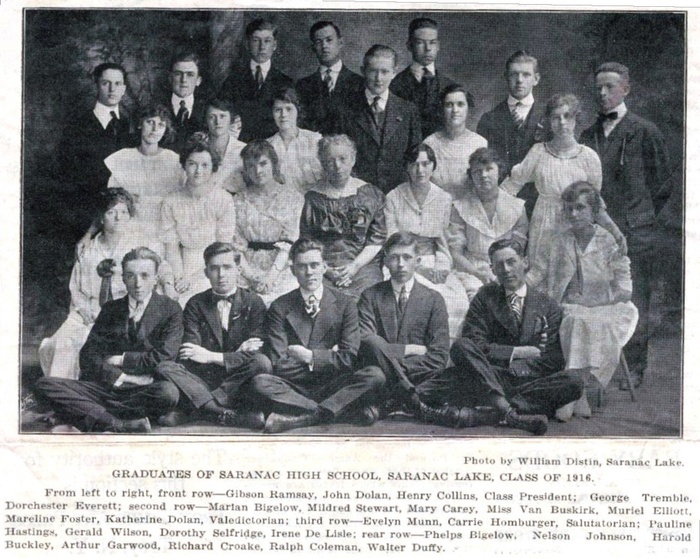 Saranac Lake High School Class of 1916, HSL Collection, 2009. Nine members of this graduating class served in the World War I. We have a page on one, Dorchester Everett, who served in the navy.
Saranac Lake High School Class of 1916, HSL Collection, 2009. Nine members of this graduating class served in the World War I. We have a page on one, Dorchester Everett, who served in the navy. 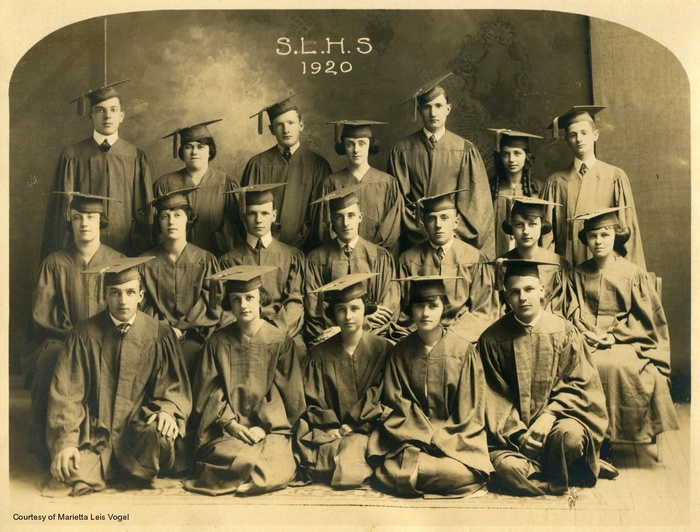 Saranac Lake High School Class of 1920. The photograph was run in the October 26, 1955 Enterprise: "Proudly wearing their caps and gowns is this group of Saranac Lake High School graduates, some of whom will be in the village this weekend for the Homecoming Weekend sponsored by the Women's Civic Chamber. From left to right, front row: William LaPan, Margaret Munn Delahant, Kathryn Everett Chigwidden, Harriet Favro Longtemps and George M. Flynn — Second row: Ruth Browne Mann, Jeannette Oakey Bennett, Thomas F. Croake, Charles A. MacCausland, Lee S. Benson, Virginia Ward Linters, Kathryn LaVallee Conlin — Back row: George Leis, Ruth Ledger, George W. Foy, Veronica Stringham Adler, Bernard M. McCormick (deceased), Emily Mirick St. Clair and Leo A. Wise. (The photograph was taken by William L. Distin and loaned to The Enterprise by Mrs. Kathryn Peightal.) HSL Collection, 2009.
Saranac Lake High School Class of 1920. The photograph was run in the October 26, 1955 Enterprise: "Proudly wearing their caps and gowns is this group of Saranac Lake High School graduates, some of whom will be in the village this weekend for the Homecoming Weekend sponsored by the Women's Civic Chamber. From left to right, front row: William LaPan, Margaret Munn Delahant, Kathryn Everett Chigwidden, Harriet Favro Longtemps and George M. Flynn — Second row: Ruth Browne Mann, Jeannette Oakey Bennett, Thomas F. Croake, Charles A. MacCausland, Lee S. Benson, Virginia Ward Linters, Kathryn LaVallee Conlin — Back row: George Leis, Ruth Ledger, George W. Foy, Veronica Stringham Adler, Bernard M. McCormick (deceased), Emily Mirick St. Clair and Leo A. Wise. (The photograph was taken by William L. Distin and loaned to The Enterprise by Mrs. Kathryn Peightal.) HSL Collection, 2009. 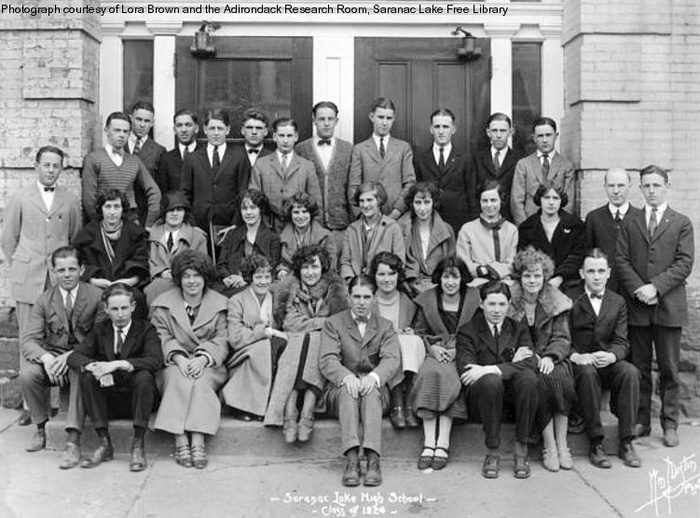 Saranac Lake High School Class of 1924, the last class to graduate from the old high school. Left to right — front row: Anthony Gedroiz, Edward Rice, Eileen Dupree, Marion Devereux, Marion Boulley, Jack Leary, Marion Burmaster, Amerasuda Acrivlelis, Hyman Weiner, Margaret Massen and Filix Munn. Middle row: John Pedroni, Gertrude Clark, Ruth McClellan, Alice Billings, Alison Rice, Bernice Levy, Lucy Edelberg, Miss Janet Johnson (teacher, class chaperone), Genevieve Vandeburgh, Edward Summerville and Fremont Walker. Back row: Merrill Thomas, Daniel Hayes, Henry Leis, Richard Lytle, George Hogan, John Little, Alfred Bendell, Kenneth Toof, Ralph Davidson, Morrison Chambers and John Morgan. (Caption information by Jack Leary, Adirondack Daily Enterprise, August 4, 2008)
Saranac Lake High School Class of 1924, the last class to graduate from the old high school. Left to right — front row: Anthony Gedroiz, Edward Rice, Eileen Dupree, Marion Devereux, Marion Boulley, Jack Leary, Marion Burmaster, Amerasuda Acrivlelis, Hyman Weiner, Margaret Massen and Filix Munn. Middle row: John Pedroni, Gertrude Clark, Ruth McClellan, Alice Billings, Alison Rice, Bernice Levy, Lucy Edelberg, Miss Janet Johnson (teacher, class chaperone), Genevieve Vandeburgh, Edward Summerville and Fremont Walker. Back row: Merrill Thomas, Daniel Hayes, Henry Leis, Richard Lytle, George Hogan, John Little, Alfred Bendell, Kenneth Toof, Ralph Davidson, Morrison Chambers and John Morgan. (Caption information by Jack Leary, Adirondack Daily Enterprise, August 4, 2008) 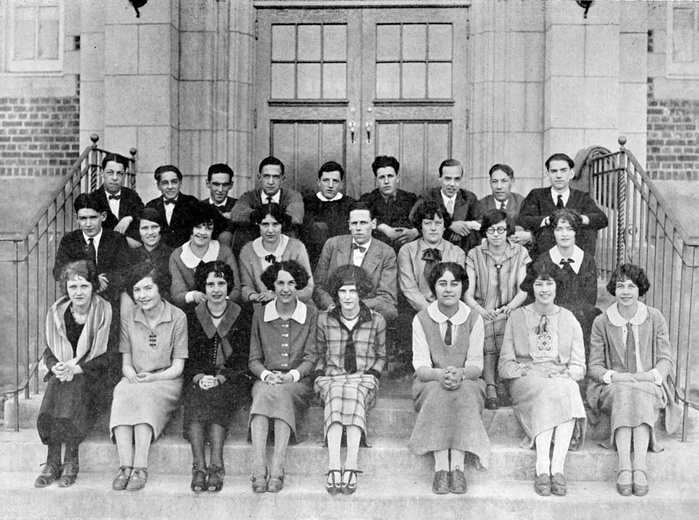 Saranac Lake High School Class of 1925 from the 1925 Mazda. Courtesy of the Adirondack Research Room, Saranac Lake Free Library Adirondack Daily Enterprise, June 12, 1984
Saranac Lake High School Class of 1925 from the 1925 Mazda. Courtesy of the Adirondack Research Room, Saranac Lake Free Library Adirondack Daily Enterprise, June 12, 1984
On a cool June morning in 1896, the school's first graduate walked out of SLHS and into life's mainstream. He was the only member of the class! Proud, isolated, honored . . . and unsung.
He is unique and he is forgotten. The first graduate should command at least a kind of reverence more or less associated with the unknown soldier.
Forgotten or not, the high school itself took some very dramatic and forward leaps at the time of his exit.
The move into the graduation "high-jinx era" was far in the future. The barrel rush had not been heard of. That first graduate had no way of letting off steam prior to receiving his sheepskin.
The barrel rush was born of sheer springtime exuberance and, for the moment, preservation of life and limb was a tenuous gamble, a survival test and a rude introduction to the Machiavellian treachery dreamed up by juniors and seniors locked in head-to-head combat.
School courses in the 1890's were strictured rather than structured. The science department was in the basement of the Methodist church next door . . . a few tables, test tubes and Bunsen burners.
When the church became too small for its congregation, the building became the Odd Fellows Hall.
Athletics, if any, were low key. The biggest challenges were in the realm of public speaking. Forceful orators were considered big men on campus and continued their battles right up to the state level. Annual speaking contests were the lifeblood of competition and the preparation and delivery techniques occupied a great segment of the school year.
The principal of the school, Professor Weld, taught science and organized the Cadet Corps. It may be difficult to envision today but the cadets were the forerunners of the lettermen sheiks of the Varsity Club.
The Varsity Club was the brainchild of Bob Herron, Bill Lytle and Floyd Ahern in 1925. Bob was both a great organizer and a gifted athlete who turned down several scholarship offers.
Military drills were held in place of gym classes. There was no threat of war at this time. The drills were mostly fun and gun exercises set to martial music.
Hockey had become a school sport and the only activity that commanded respect since nearby communities were plunged into the same type of activity. Ice time rivalry became hot and wheezy.
In itself, hockey was warlike and baseball was not far behind as a very physical type game. Starks Hardware recognized baseball for the game it was and advertised "baseball clubs" for sale instead of bats.
The skating rink in the 1890's was located on the site of the Catholic Church. Skating with girls, a social art, combined with singing pucks and slashing sticks in a kind of Roman Circus linking sports with romance.
Early in 1924, the girls began that long and arduous march to recognition and eminence where they could at least get out on the gym floor in bloomers and middie blouses and tussle at basketball with the town girls.
In the village, the school had become everything to everybody. A glee club organized in 1900 quickly developed into showtime operettas. In 1922, William Morris, the famous N.Y.C. theatrical agent, organized the Saranac Lake Boys' Band. It was taken over by the school in 1929. Saranac Lake had exceptionally fine bands and were consistent winners at Syracuse University's state finals under Willard Greene during the 1930's.
Albert Gummer, a talented trumpet player, went directly from high school into the United States Navy Band and played until retirement and he never came back to Saranac Lake.
Walter Nutter played the loudest trumpet in school history and in the 1930's and 40's while playing at the Birches was only allowed to toot his horn if he faced the wall.
The late Carlton Kilroy, as a 15-year old kid, played drums in a roadhouse called the Mt. Baker Club which was frequented by prohibition era gangsters, their molls and several floating courtesans from Montreal.
When Prof. H. V. Littell got wind of it, the school board met in cacophonous cadence and squelched Carl's income. He was warned not to pursue employment in such dens of sin until after graduation or at age 18, whichever came first.
Sports and athletic contests have always been a prime magnet for muscular boys who desire quick recognition. At one time a triple-threat halfback who couldn't pronounce the word "cat" was usually far-better known than the valedictorian. Nowadays, schools try to combine both sinew and scholastic aptitude on a higher level.
Football appeared on the scene for the Red and White when Coach Russel Sackett introduced this form of gladiatorial mayhem in the fall of 1924. It caught on so quickly that Saranac Lake High School became a recognized north country powerhouse by 1926.
Our most talented players received scholarships to Georgetown University. The greatest halfback of the early Wilson years was Wally Herron, though many feel that Tom Wallace was his equal and in some respects, even superior.
School journalistic talent first surfaced with the publication of the "Senior Record." The "Mazda" years were followed and eventually "Mazda" evolved into the "Red and White," a consistent winner in state scholastic competition.
The first Canaras came out in 1926. The oldest class ring around town is on the finger of Bertha Mussen. It is a plain gold band with the raised school insignia featured. It has both taste and simplicity!
Who else would ask? For the pure hell of it, I inquired of Bernard Brown, the Marine legend and a former police officer who played with the football greats of that golden era, if he ever drank Dr. Chelpen's Acidophilus Milk which was being advertised by A.C. Bartz in 1931.
He said "no" but he remembered the Bartz slogan . . . you can't beat our milk but you can whip our cream." So much for the raw milk days when Bernard was a gridiron great.
Malone Gazette, December 23, 1892
The people of Saranac Lake formally opened their new school building last Friday night. The State superintendent of public instruction attended the exercises which were followed by a public reception. School Commissioner McClary, of this district, was also present by invitation. The building is described as handsome and substantial and was built at a cost of $10,000.
Franklin Gazette, March 20, 1896
On March 27th a special school meeting will be held in the village district to vote on the question of bonding the district for $9,000 for the erection of an addition to the present school building.
Malone Palladium, June 28, 1906
The entire registration in the Saranac Lake school for the year ending August 31, 1896, was 949. In the high school there were 114 students.
Malone Farmer, March 24, 1909
The Saranac Lake High School is to have an oratorical contest April 2nd, in which five young ladies and six young gentlemen will compete for $30 in gold to be distributed to the two of each sex who are judged to be the best speakers. The first prizes will be $10 each and the second prizes $5 each. [equivalent to ~$340 and $120 today]
Lake Placid News, June 13, 1924
FIREMEN SAVE SARANAC LAKE HIGH SCHOOL FROM SERIOUS NIGHT FIRE
OLD BUILDING IS THREATENED WHEN WIRE STARTS FIRE
Quick Alarm and Response Enables Firemen to Keep Blaze in One Room; School Continues
Prompt and efficient work on the part of the Saranac Lake Fire Department saved the Saranac Lake High School building in Main street Wednesday night when fire, believed to have been caused by a short circuit started in a storeroom of the basement directly beneath the Fresh Air Room.
The flames were confined to one room. Considerable damage was caused by water and one partition was ripped out. Regular school sessions, however, were held on Thursday.
The fire was discovered shortly after ten o'clock at night by residents of a house in Main street directly across from the school building. Great clouds of smoke, which at first were thought to be fog, were hanging over the street. Then the smell of burning wood flooded the street.
Officer M. M. Jones was called by telephone as it was impossible to trace the fire. An investigation at the rear of the school building in Main street showed that the flames were in the rear of that building. Orlie Greene turned in an alarm and the Fire Department was on the scene almost immediately.
Quick work by the fire fighters made possible the running of numerous hose lines which quickly quelled the flames. The smoke, however, continued for several hours. Chief of Police Frank E. Sheldon directed his men in the task of controlling the large crowd that bled from all parts of the village.
While the smoke was still pouring from the building, members of the Saranac Lake Boys' Band climbed the fire escapes to the third floor and removed the band instruments. Shortly after the arrival of the engine a second alarm was turned in and every available piece of five apparatus was on the scene.
The fire caused a near-panic among residents of Main street, St. Bernard street and Berkeley Hotel guests. Several persons began to pack, but were reassured by the firemen.
The fire took place at one of the most congested parts of the village and the work of the firemen prevented what might have been on of the worst fires in the history of the village.
The school building, even before the work on the new school building began, was declared to be a fire menace. The Fire Department, however, proved it is equal to the task of coping with the most serious fires.
Just the day before the fire the pupils of the school had a fire drill in which the building was emptied in two minutes and five seconds.
First Saranac Lake High School Graduates
1896 Francis H. Slater
1897 (None)
1898 Hattie Bryant (Shelley), Clara V. McClelland (Barton), Edna I. Mumford
1899 John Reid, Minnie Stickney, Carrie M. LaBounty, Lena McClelland, Sylvia Jenkins (m. Walter Jenkins), Willard Reid, Esther Perry, Adah Otis (Hapeman), George Utting, Charlotte White, Phoebe Hall (Valentine), Miss Wicker
1900 Maude J. Corey, John Collins, Charles J. Stickney, Jr., Katherine Ward, Elizabeth Cantwell, Sarah Cantwell, Joseph Cantwell, Claude C. Durgan, George Estes, Thomas J. Farrell, Jr., Mabel C. Gay (Rivest), Nettie Hale (Rath), Jamie W. Weld, Roy R. Wright
1901 Ernest W. Ayer, Raymond D. Blauvelt, Julia Conklin, William G. Distin, Ernest E. Keet
- Local architect William G. Distin, who designed a number of Adirondack Great Camps and the St. John's in the Wilderness Episcopal Church.
- New York State's 4th Judicial District (Franklin County) Judge Cornelius J. Carey was a graduate of Saranac Lake High School, and a 1930 graduate of Notre Dame. At 29, he was the youngest judge in New York.
- Ed Lamy was an international speed skating champion. From 1908 to 1910 he was the Senior National North American and U.S. Long Track Champion. He also held records for the broad jump on ice. He was elected to the Speed Skating Hall of Fame on May 20, 1961 at Minneapolis, Minnesota.
- Petrova School
- New Saranac Lake High School
- Canaras
- WW I - SLHS Class of 1916
- WW I - SLHS Class of 1918
- Saranac Lake High School Graduates
- Saranac Lake High School Alma Mater
Footnotes
1. Dora, Donna and Mildred Keough, eds., A Past To Remember, A Future to Mold, Saranac Lake: The Chamber. 2001
2. Sanborn maps for 1895, 1899, and 1903
3. Duquette, Ruth, "Saranac Lake Schools", unpublished manuscript D946, Adirondack Research Room, Saranac Lake Free Library
4. For more information on this photograph and caption, see Old Saranac Lake photographs



